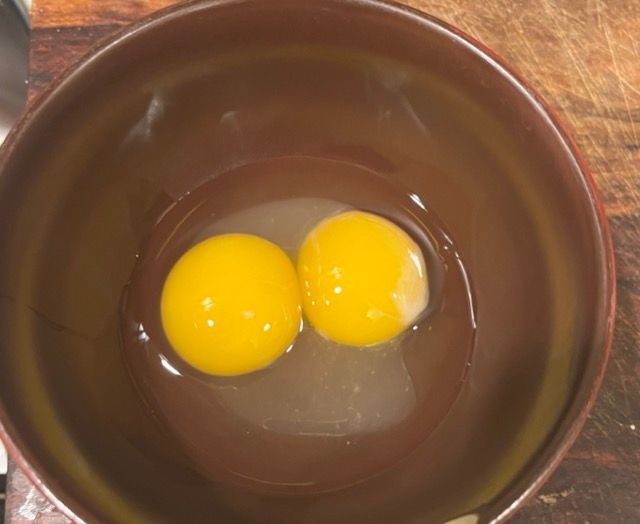Double Yolk
-
I made breakfast for Mrs. George yesterday AM. To my surprise, the egg I cracked open had a double yolk. I don't remember the last time I saw that.
So, today, I made breakfast again...

https://www.bbc.com/news/magazine-16118149
So, if the probability of finding an egg with two yolks is 1/1000 - then to find the likelihood of discovering four in a row you simply multiply the probabilities together four times. One thousand to the power of four brings us to the grand total of one trillion - that's the new-school US-style trillion with 12 zeroes.
If true that would mean the event that occurred in Jen's kitchen was a trillion-to-one event. But is it true? No is the short answer.
It's not as simple as that. What you have to consider is the fact that these eggs may be likely to come in clusters.
Here we need to turn to an expert. Richard Kempsey is agriculture director at Stonegate, which supplies eggs to supermarkets. He says double-yolked eggs almost always come from young hens about 20-to-28 weeks old.
The chances of getting a double-yolk from one of these hens is much higher. One in every 100 eggs from these birds are double-yolk.
We've also learned from our research that the eggs in a box are very likely to come from the same flock, and flocks are usually around the same age. On that basis we can say that while chance of finding one double-yolk egg may be 1/1000, the chance of finding a second is considerably higher - more like 1/100.
And the same goes for the third and fourth eggs. So taking all that into account lets do the sum 1000 x 100 x 100 x 100 - that equals one billion - so the probability of finding four eggs in a row in a single box is one in a billion.
A one-in-a-billion event is still pretty big, although compared to a one-in-a-trillion chance the difference is huge. A trillion is 1000 bigger than a billion and amounts to the difference between something happening once a week compared with once every 20 years.
So the event that occurred in Jen's kitchen was a billion-to-one event? Probably not. There's another big factor we need to consider - the size of the eggs. Double-yolk eggs are far more likely to be large. Yet the eggs that young birds lay are normally small.
-
The End Times are upon us.
Again.
-
We somewhat have talked about this topic before LOL
-
I made breakfast for Mrs. George yesterday AM. To my surprise, the egg I cracked open had a double yolk. I don't remember the last time I saw that.
So, today, I made breakfast again...

https://www.bbc.com/news/magazine-16118149
So, if the probability of finding an egg with two yolks is 1/1000 - then to find the likelihood of discovering four in a row you simply multiply the probabilities together four times. One thousand to the power of four brings us to the grand total of one trillion - that's the new-school US-style trillion with 12 zeroes.
If true that would mean the event that occurred in Jen's kitchen was a trillion-to-one event. But is it true? No is the short answer.
It's not as simple as that. What you have to consider is the fact that these eggs may be likely to come in clusters.
Here we need to turn to an expert. Richard Kempsey is agriculture director at Stonegate, which supplies eggs to supermarkets. He says double-yolked eggs almost always come from young hens about 20-to-28 weeks old.
The chances of getting a double-yolk from one of these hens is much higher. One in every 100 eggs from these birds are double-yolk.
We've also learned from our research that the eggs in a box are very likely to come from the same flock, and flocks are usually around the same age. On that basis we can say that while chance of finding one double-yolk egg may be 1/1000, the chance of finding a second is considerably higher - more like 1/100.
And the same goes for the third and fourth eggs. So taking all that into account lets do the sum 1000 x 100 x 100 x 100 - that equals one billion - so the probability of finding four eggs in a row in a single box is one in a billion.
A one-in-a-billion event is still pretty big, although compared to a one-in-a-trillion chance the difference is huge. A trillion is 1000 bigger than a billion and amounts to the difference between something happening once a week compared with once every 20 years.
So the event that occurred in Jen's kitchen was a billion-to-one event? Probably not. There's another big factor we need to consider - the size of the eggs. Double-yolk eggs are far more likely to be large. Yet the eggs that young birds lay are normally small.
@George-K I hope you went out and bought a lottery ticket!!!